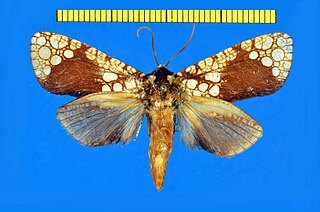
Dudgeonea is a small genus of moths and the only genus of its family, the Dudgeoneidae. It includes six species distributed sparsely across the Old World from Africa and Madagascar to Australia and New Guinea.

Castniidae, or castniid moths, is a small family of moths with fewer than 200 species: The majority are Neotropical with some in Australia and a few in south-east Asia. These are medium-sized to very large moths, usually with drab, cryptically marked forewings and brightly coloured hindwings. They have clubbed antennae and are day flying, and are often mistaken for butterflies. Indeed, some previous classification systems placed this family within the butterflies or skippers. The Neotropical species are commonly known as giant butterfly-moths, the Australian and Asian species as sun moths. The larvae are internal feeders, often on roots of epiphytes or on monocotyledons.

Brachodidae is a family of day-flying moths, commonly known as little bear moths, which contains about 135 species distributed around much of the world. The relationships and status of the presently included genera are not well understood.
Arotrophora arcuatalis, commonly known as banksia boring moth or rarely banksia moth, is a species of Australian tortrid moth best known as a pest of Banksia.

Hyalobathra is a genus of moths of the family Crambidae. The genus was erected by Edward Meyrick in 1885.
Leguminivora is a genus of moths belonging to the subfamily Olethreutinae of the family Tortricidae.
Microsarotis is a genus of moths belonging to the subfamily Olethreutinae of the family Tortricidae.
Beryllophantis is a genus of moths belonging to the subfamily Tortricinae of the family Tortricidae.
Williella is a genus of moths belonging to the subfamily Tortricinae of the family Tortricidae.
Pammenopsis is a genus of moths belonging to the family Tortricidae.
Whittenella is a genus of moths of the family Tortricidae containing the sole species Whittenella peltosema.
The Bactrini are a tribe of tortrix moths.

Cadra is a genus of small moths belonging to the family Pyralidae. The genus Ephestia is closely related to Cadra and might be its senior synonym. Several of these moths are variously assigned to one or the other genus, in particular in non-entomological sources. Cadra and Ephestia belong to the huge snout moth subfamily Phycitinae, and therein to the tribe Phycitini.
Cadra acuta is a species of snout moth in the genus Cadra. It was described by Marianne Horak in 1994. It is found in the Northern Territory as well as on the Cape York Peninsula in Australia.
Cadra corniculata is a species of snout moth in the genus Cadra. It was described by Marianne Horak in 1994. It is found in western Australia.
Cadra rugosa is a species of snout moth in the genus Cadra. It was described by Marianne Horak in 1994. It is found in central Australia.

Ogmograptis, the scribbly gum moth, is a genus in the family Bucculatricidae and was first described by Edward Meyrick in 1935, as a monotypic genus. They are found in the Australian Capital Territory, New South Wales and Queensland. However, in 2007, Cooke and Edwards argued that the patterning of the scribbles was different for each of the three eucalypts, Eucalyptus pauciflora, E. racemosa ssp. rossii, and E. delegatensis) and that it was likely that these differing patterns were caused by larvae from different species of scribbly gum moths.
Hyalobathra crenulata is a moth in the family Crambidae. It was described by Hari Sutrisno and Marianne Horak in 2003. It is found in Australia, where it has been recorded from Queensland.
Egon Horak is an Austrian mycologist who has described more than 1000 species of fungi, including many from the Southern Hemisphere, particularly New Zealand and South America. He was an executive editor of the scientific journal Sydowia from 1975 to 1989, and a member of the editorial board afterwards.
Marianne Horak is a Swiss-Australian entomologist who specialises in Australian Lepidoptera, particularly the phycitine and tortricid moths. She also did important research on the scribbly gum moths, during which eleven new species of Ogmograptis were discovered.





